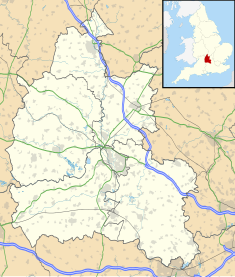County Hall, Oxford
| County Hall, Oxford | |
|---|---|
 County Hall, New Road, Oxford | |
| Location | Oxford, Oxfordshire |
| Coordinates | 51°45′06″N 1°15′42″W / 51.7518°N 1.2618°W |
| Built | 1841 |
| Architect | John Plowman |
| Architectural style(s) | Gothic Revival style |
Listed Building – Grade II* | |
| Designated | 29 January 1968 |
| Reference no. | 1047201 |
County Hall is a municipal building on New Road in Oxford, Oxfordshire, England. County Hall, which is the headquarters of Oxfordshire County Council, is a Grade II* listed building.[1]
History[edit]
In the early 16th century the assizes and quarter sessions were held in a sessions house in the grounds of Oxford Castle but towards the end of the century they were moved to Oxford Town Hall.[2] After deciding in the early 19th century that this arrangement was inadequate for their needs, the justices decided to procure a dedicated building within, what was then, the castle grounds.[2]
The building, which was designed by John Plowman in the Gothic Revival style, was completed in 1841.[1][3] The design involved a symmetrical castellated main frontage of five bays facing New Road: the central section featured a projecting castellated porch containing a round headed doorway with a small round headed window above encircled with the inscription "County Hall A.D. MDCCCXLI" ("County Hall A.D. 1841"); there were turrets at roof level and the other bays contained round headed windows.[1] Sir Charles Oman described it as "quite the most abominable pseudo-Gothic Assize Court in all England".[4]
The building continued to be used as a facility for dispensing justice but, following the implementation of the Local Government Act 1888, which established county councils in every county, it also became the meeting place of Oxfordshire County Council.[5]

The limited office space at County Hall required the council to establish other premises for its staff. In 1911–1912 a new building called "County Offices" was built at the corner of Tidmarsh Lane and New Road, lying on the opposite side of the castle mound from County Hall. County Offices was designed by William Austin Daft and built in white limestone with yellow sandstone dressings. Council meetings continued to be held at County Hall, with County Offices being the main administrative building.[6][7]

By the early 1970s the council had outgrown County Offices. A modern facility, known as "New County Hall", was designed by the County Architect to accommodate the County Council's administrative staff: it was built adjacent to the original 1841 County Hall and was completed in 1973.[8][9][a] The design for the five-storey building involved continuous bands of glazing with concrete panels above and below.[12]
The old building continued to be used as a courthouse – it was the venue for the trial and conviction of Donald Neilson for the kidnapping and murder of Lesley Whittle in July 1976[13] – until the new Oxford Combined Court Centre in St Aldate's was completed in October 1985.[14] Meetings of the county council continued to be held in the council chamber located within the old County Hall.[15]
The 1912 County Offices at Tidmarsh Lane is now used as the Oxford register office.[16] The county record office, which had been based in the basement of the new County Hall, moved to St Luke's Church in Temple Cowley in January 2001.[17]
Notes[edit]
References[edit]
- ^ a b c Historic England. "County hall with the curving screen walls and turretts on either side (1047201)". National Heritage List for England. Retrieved 14 September 2019.
- ^ a b Eleanor, Chance; Christina, Colvin; Cooper, Janet; Day, C. J.; Hassall, T. G.; Jessup, Mary; Selwyn, Nesta (1979). "'Castle', in A History of the County of Oxford: Volume 4, the City of Oxford, ed. Alan Crossley and C R Elrington". London: British History Online. pp. 296–300. Retrieved 22 October 2020.
- ^ "Old County Hall (1841)". Oxford Preservation Trust. Retrieved 22 October 2020.
- ^ Oman, Sir Charles (1926). Castles. The Great Western Railway. p. 44.
- ^ "Local Government Act 1888". Legislation.gov.uk. Retrieved 17 August 2019.
- ^ "Oxfordshire County Council: County Offices". Oxford Journal. 11 January 1911. p. 2. Retrieved 23 November 2022.
- ^ Graham, Malcolm (2016). Oxford Heritage Walks Book 4 (PDF). Oxford: Oxford Preservation Trust. p. 29. Retrieved 23 November 2022.
- ^ Rhodes, John; Munby, Julian (2008). Castle, Canal & College: Worcester Street Car Park & related areas, Oxford. Oxford: Oxford Preservation Trust. pp. 16–17.
- ^ "Aerial photo of west central Oxford, looking south-east from Worcester Street car park to Folly Bridge". Oxfordshire History Centre. Retrieved 22 October 2020.
- ^ "The Swan & Castle, Oxford". J. D. Wetherspoon. Retrieved 22 October 2020.
- ^ "Review: An Inventory of Non-conformist Chapels and Meeting Houses in Central England" (pdf). The Local Historian. 1 February 1988. p. 30. Retrieved 22 October 2020.
- ^ "County Hall building in New Road, Oxford, England. United Kingdom". Alamy. Retrieved 4 February 2023.
- ^ "Legacy of Black Panther murders". BBC News. 27 January 2010. Retrieved 4 February 2023.
- ^ "Oxford Inscriptions: William Morris, Lord Nuffield". Oxford Inscriptions. Retrieved 2 February 2023.
- ^ "Full Constitution" (PDF). pp. 3–4. Retrieved 14 September 2019.
- ^ "Registration offices". Oxfordshire County Council. Retrieved 23 November 2022.
- ^ "St Luke's Church in Temple Cowley" (PDF). British Brick Society. 1 September 2003. p. 6. Retrieved 22 October 2020.

